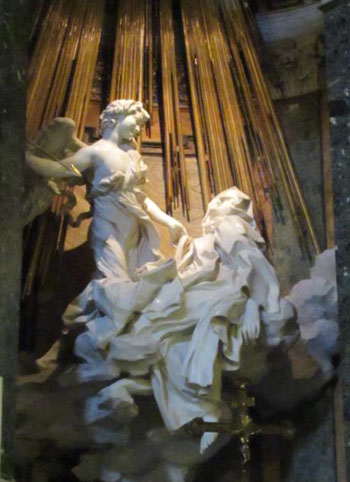
At the church of Santa Maria della Vittoria in Rome, St. Teresa of Avila is depicted in marble by Gian Lorenzo Bernini in The Ecstasy of Saint Teresa. Completed in 1652, the sculpture depicts the mystic’s vision of being pierced by an angel’s arrow. “So surpassing was the sweetness of this excessive pain, that I could not wish to be rid of it,” she wrote in her autobiography. (CNS photo/Mike Nelson)
To the side of the altar at the church of Santa Maria della Vittoria in Rome, not far from the Termini train station, is one of the High Baroque era’s most famous sculptures: The Ecstasy of Saint Teresa.
Completed by Roman master Gian Lorenzo Bernini in 1652 (only 70 years after Teresa’s death and 30 after her canonization), the white marble sculpture depicts a vision of the 16th-century saint from Avila — the reformer of the Discalced Carmelites — in which she is pierced by an angel’s golden spear, a moment she said left her “all on fire with a great love of God.”
“The pain was so great, that it made me moan,” she wrote in “The Life of Teresa of Jesus,” her autobiography. “And yet, so surpassing was the sweetness of this excessive pain, that I could not wish to be rid of it. The soul is satisfied now with nothing less than God.”
I read this account before visiting Santa Maria della Vittoria with my wife last year. I found it amazing, startling, and just a little hard to accept.
The “sweetness” of excessive pain? Ecstasy? How, I asked myself, as I gazed on Teresa’s face.
Such is the mystery and (for many) the appeal of the mystic, one chosen by God to receive particular gifts and graces. And perhaps it is presumptuous for us to believe that we can ever fully understand mysticism; if we fully understood, would we call them mystics?
But we can appreciate and even gain something from a mystical presence. In the case of Teresa of Avila, her inspirational writings offer us a great deal, perhaps best exemplified by “The Way of Perfection.”
[hotblock]
Directed to the sisters of her order, Teresa wrote “The Way” during a tumultuous time among Catholics — the spread of the Reformation throughout Europe. Considering that the church is almost always under critique, if not attack, from some quarter of society, “The Way” is entirely appropriate for modern audiences.
And while hardly a quick or easy read, “The Way” gives us much on which to ponder, beginning with a humility that I find appealing and inviting. “I shall speak of nothing,” she says in her prologue, “of which I have no experience, either in my own life or in observation of others, or which the Lord has not taught me in prayer.”
Within her engrossing reflection on the Lord’s Prayer, I found particular meaning in Chapter 42 (“Deliver Us From Evil”):
“How differently shall we then incline our wills toward the will of God!” Teresa observes. “His will is for us to desire truth, whereas we desire falsehood; his will is for us to desire the eternal, whereas we prefer that which passes away; his will is for us to desire great and sublime things, whereas we desire the base things of earth; he would have us desire only what is certain, whereas here on earth we love what is doubtful.”
How often in my life have I desired objects and relationships, plaudits and praise, that are both shallow and fleeting? What about the desire to be one with God, in mind and being, body and soul?
[hotblock2]
Judging by her expression in Bernini’s sculpture, in this vision that might horrify the rest of us, Teresa is, well, ecstatic at the prospect of true unity with God. There is no fear, no panic — only a joyfully willing acceptance.
The denial of earthly desires: Could denial of life itself be one of them? Is that why Teresa felt ecstasy? Did she, in fact, see the angel piercing her heart as a means to eternal life with God?
In my desire to “understand,” I do not wish to overanalyze or overspeculate on what this remarkable mystic is trying to share with us through her vision. I only know that she has opened a new way to explore what God wants of and for all of us in our lives.
***
Catholic journalist Mike Nelson writes from Southern California.



His will is our peace and the we strive for divine blessings God blessed with infinite ecstatic joys even in the experience of tremendous suffering. That is why Saint Thomas Aquinas teaches us that we can the true cost of discipleship by meditating on the crucified Christ. God bless all who bear his cross, Fr ralph